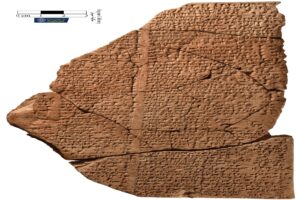A fresco recently unearthed at an archaeological site at Pompeii appears to show an ancient precursor to pizza. And in a twist sure to boil the blood of any Italian reading this: There is fruit in dangerous proximity to the dish.
One of the fruits in question is scandalously pineapple-esque, though it most certainly isn’t actually a pineapple. The first European to encounter that deliciously spiky fruit was Christopher Columbus in 1493. So relax, pizza Puritans: The ancient Romans weren’t peppering pies with pineapple pieces. But other ingredients? Sure!
The fresco depicts a piece of focaccia bread served up on a silver platter and topped with moretum, a type of garlicky ancient Roman cheese spread. Dried fruit, pomegranates, and dates are resting nearby and — in some cases — spilling over onto the “pizza.” There’s also that weird, yellow pineapple-reminiscent object.

Gabriel Zuchtriegel, the director of the Pompeii historical site, shows off the pizza fresco in a screenshot from a video by The Guardian.
“In ancient Pompeii, we already knew that there were forms of flatbread, made with grains, water, salt, and maybe beer as a leavening agent,” Gino Sorbillo, owner of a pizzeria in Naples, told The Guardian. “Then they might have topped it with vegetables or the fish of the day…it was an ancient form of pizza.”
Flatbread with cheese and toppings is pretty much the definition of pizza, though how far that definition stretches, especially regarding toppings, is up for debate. Certainly, even the earliest and most traditional Naples margherita pizzas include tomatoes — a food that didn’t reach Italy until a millennium and a half after Mount Vesuvius erupted in 79 AD and destroyed the Roman vacation town of Pompeii.
Researchers unearthed the fresco during excavations of Regio IX, an area of Pompeii that contained residential buildings, workshops, and a bakery. Archaeologists discovered three human skeletons in the bakery and more frescos in the surrounding buildings. Those frescos include scenes of Apollo, Daphne, Poseidon, and Amymone, among other figures, according to The Guardian.
To return to the “fruit on pizza” debate one last time, I feel obliged to point out that while tomatoes are culinarily a vegetable, they are technically a fruit. So would that make it acceptable to the people of Naples if the mysterious yellow object was, however impossible, a pineapple?
“No. We make traditional pizza and would never use pineapple,” Sorbillo insisted.
Guess that answers that.






